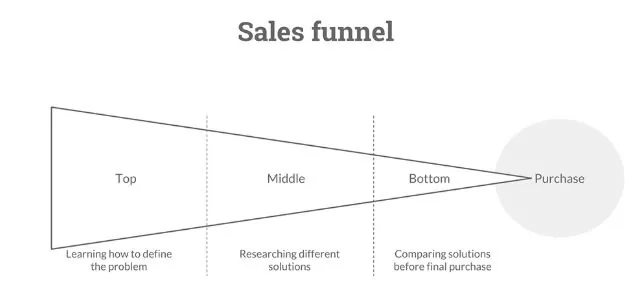So, I hope you’ve read our article on search intent, and if you haven’t, you should. The search intent is a great way to segment and develop things within the SEO world, but in reality, it’s the first step in the end goal of SEO – increasing branded interactions and making money for businesses. And to understand just how search intent does this, it’s even more important to understand the concept of the sales funnel.
The Sales Funnel is how we imagine the process of purchasing a product from beginning to end in terms of sales and searches. The goal of the sales funnel is to analyze and map content to understand just how it leads to purchases made. Here’s what the sales funnel looks like courtesy of Moz.
The first part of the funnel is the “top”, which is essentially the first time someone looks up how to understand a problem they are having. The reason top is so wide is because the searches are incredibly wide. You’re far from a sale at this point because people are just now finding out the roots of an issue and how to fix it, not worrying about what they’re going to do to respond to it. This correlates with informational search intent, since at the top of the funnel, people are trying to find information, not solutions, at this point.
The second part is the “middle”, which is when people are beginning to look for solutions to the problem they just learned about. This is in the middle of the sales funnel because you’re one step closer to closing a sale since people are now actively seeking a solution to the problem that they are having. This is mostly transactional search intent, since the people will more than likely be browsing products and ad results to see what the market usually asks for or has to solve their issue. This can also delve into the other two kinds of search intent since the middle is broad in terms of what exactly people will be searching for.
The last part of the sales funnel is the “bottom”, which is the closest to the end goal of closing a purchase. This is when people are mapping their plan of attack for making a purchase. They’ve gathered their information, figured out how they want to solve a solution, and are now deciding where their money will go. This is, as a result, the most competitive portion of the market, and where you’ll see the most ads and e-commerce results. This is navigational search intent, since people are wanting to go in person and close a sale or close a sale online.
So, why do we try to understand the sales funnel? Our goal is closing sales for businesses, and if we understand the sales funnel, it makes SEO that much easier. By ranking for key terms and phrases that show up towards the bottom end of the funnel, you put yourself in a better place to close sales and be smart in a competitive market. Plus, digital marketing uses the sales funnel to manage ad placement and try to use ad money in the most efficient way.
Own the Sales Funnel
Have Searchlaytics help you convert sales and dominate your market.
Get Your SEO Straight




